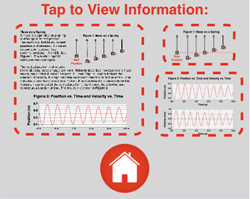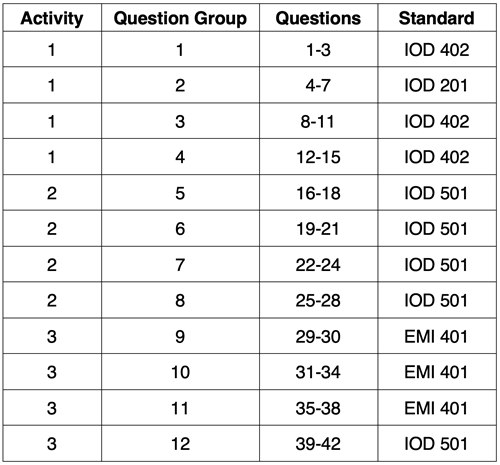About the Science Reasoning Center
 Highly Recommended
Highly RecommendedLike all our Science Reasoning Center activities, the completion of the Vibrating Mass on a Spring activity requires that a student use provided information about a phenomenon, experiment, or data presentation to answer questions. This information is accessible by tapping on the small thumbnails found on the bottom right of every question. However, it may be considerably easier to have a printed copy of this information or to display the information in a separate browser window. You can access this information from this page.
The Standards
The Vibrating Mass on a Spring activity describes the up and down motion of a mass on a spring using a diagram, a position-time graph, and a velocity-time graph. Questions target a student's ability to select values from a graph, to combine information from two different graphs to draw appropriate conclusions, to identify the amplitude and the period, and to interpret the graphs in light of information on a diagram. Success with the activity requires some degree of understanding or proficiency with respect to ...
- Analyzing and Interpreting Data(Science and Engineering Practice 4.1)
Analyze data using tools, technologies, and/or models (e.g., computational, mathematical) in order to make valid and reliable scientific claims or determine an optimal design solution. - Using Mathematics and Computational Thinking (Science and Engineering Practice 5.3)
Use mathematical, computational, and/or algorithmic representations of phenomena or design solutions to describe and/or support claims and/or explanations. - Patterns (Crosscutting Concept 1.2)
Empirical evidence is needed to identify patterns. - Stability and Change (Crosscutting Concept 7.4)
Change and rates of change can be quantified and modeled over very short or very long periods of time. Some system changes are irreversible.
While the Vibrating Mass on a Spring activity addresses the two NextGen Science and Engineering Practices and the Crosscutting Concepts above, the activity drew its greatest inspiration from ACT's College Readiness Standards for Science Reasoning. The activity consists of 42 questions organized into 12 Question Groups and spread across the three activities. Two strands (Interpretation of Data - IOD and Evaluation of Models, Inferences, and Experimental Results - EMI) of the College Readiness Standards are addressed in this activity. The code given for the standard includes three letters to indicate the strand and three numbers to indicate the specific standard within that strand. Higher numbers are indicative of more complex science reasoning skills. The relationship between the questions and the standards is as follows:

Complementary and Similar Resources
The following resources at The Physics Classroom website complement the Vibrating Mass on a Spring Lab Science Reasoning Activity. Teachers may find them useful for supporting students and/or as components of lesson plans and unit plans.
Physics Classroom Tutorial, Vibrations and Waves: Motion of a Mass on a Spring
Physics Video Tutorial, Vibrations and Waves: Periodic Motion
Physics Video Tutorial, Vibrations and Waves: Mass on a Spring
Physics Interactives, Waves and Sound: Vibrating Mass on a Spring Simulation
Concept Builders, Vibrational Motion: Period and Frequency of a Mass on a Spring
Concept Builders, Vibrational Motion: Vibrating Mass on a Horizontal Spring - Velocity and Force
Concept Builders, Vibrational Motion: Vibrating Mass on a Vertical Spring - Velocity and Force
Concept Builders, Vibrational Motion: Energy of a Vibrating Mass on a Spring
The Calculator Pad, Simple Harmonic Motion: Problem Sets SHM1 - SHM6
Recommended: Print Passage, Tables, and Graphs
Also see: